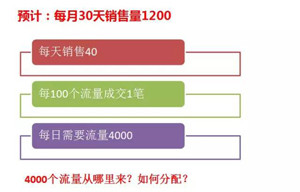Recently, many small and medium-sized sellers often ask a question: The store is in poor condition, how to do the operation? Actually, this is a big problem! But it is still necessary to sort out this out for you. As an operation, what aspects will be more effective to start improving?
1. Formulate a sales plan
Anything needs to have a strategy, and then tactical decomposition. Operation is no exception. We should first plan the overall operation plan, then break it down, and finally complete it.
For example: You have to sell 1,200 products every month, which is the goal, and then after refining, you can find that you sell 40 pieces every day. Assuming our conversion rate is 1%, we need 4,000 traffic per day. So, where does this 4,000 traffic come from? How to allocate various channel resources is the decomposition after we formulate a sales plan.
 0056.jpg
0056.jpg
In this case, there are several key points that need to be grasped: product, conversion rate, and traffic.
2. Products
1. Product selection:
The first issue in operation is choice. There is a saying that is right: choice is more important than hard work! If the direction is right, even if it is slower, there will always be a day of success. Selecting products is like choosing your own lover. If you choose the right one, your life happiness index will be higher, and choosing the wrong one will be exhausted.
So how to choose a product? Pay attention to the following 4 points: Market analysis, you need to see what the overall market trend is? Competitor analysis, where is your opponent's focus? What did they do? Customer analysis, what are the customer needs? We must look at the essence through phenomena and explore the core needs of customers. Regarding customer needs, I would like to give an example: For example, I sell tents by making outdoor products, so are customers here to buy tents? Yes, but not all! Why? Customers are buying products on the surface, but in fact they want to bring themselves a sense of happiness through the use of outdoor products. Think deeper, customers hope to experience outdoor life and get in touch with nature by using the products correctly. So the point here for customers is experience. So what kind of products are the best outdoor experience for customers? This is the core point of choice. The last one is the selling point analysis. What are your advantages? What benefits can it bring to customers? These 4 points are the core content of product selection.
2. Test model
After the product comes out, it is not directly promoted. There must be a process: testing. This principle is the same as a car. A new car does not come to the market immediately, but tests its performance, but it is a tool test, while our product test is through people. After a new product comes out, we need to use real people to test whether it can be liked by the public. Remember, it’s not that you like it or not, it has no value, but that it reaches the level of preference of a certain basic group. Depending on different categories, the number of people requirements is different, but the base of at least 1,000 is a basic starting line.
There are many ways to test models, such as: direct train, diamond exhibition, events, community fan voting, store homepage heat map, etc. The methods are different and the purpose is the same. Choose the style that everyone likes.
3. Pricing
Don’t underestimate the pricing, because the price level of your price directly divides your customer base. The low-price and low-end market determines the volume; the mid-to-high-end market determines profit. Pricing is also a comprehensive thinking process, with different methods. You can determine a reasonable method based on cost pricing method, profit pricing method, competitor pricing method, etc., but you cannot deviate from the quality attributes of your product. It must match the quality.
3. Conversion
1. Selling point
If you want to buy a good product, you must have something that touches people's hearts; and the refinement of the selling points of the page is the most core. Many customers are not greedy for cheap things, but need a reason to tell them why your product is worth the price. Therefore, the selling points need to be deeply exposed, and your selling points must bring clear benefits to customers.
2. Case Study
A good copywriting is like a story that attracts everyone to read it in unison. How to design a good copy after digging out selling points requires careful polishing. A small suggestion here is to look at the stores of competitors or excellent peers to find inspiration. If you are not sure, you don’t need to be original. You can start with imitation. Many well-selling products and content descriptions must have their reasons.
3. Vision
If you have selling points and copywriting, then you have to keep up with your appearance to have a market. Here you can communicate with the artist. Here I will give an example from my own store. At the beginning, I wrote the copywriting one by one, and then draw it one by one according to the content needs. What do you need to express? After the artist completes version 1.0, then see how to modify and adjust it. Therefore, early art and operation will inevitably require a running-in period. Here we also look at how to position. If the positioning artist is just the executor, then 1, 2, and 3 will handle the work in steps; if the positioning is the authorization of the result, then the operation and the artist need to collide with each other's ideas, and then the copywriting is completed with vision. Especially in the early stages, I suggest that the operation should take the artists to go through the process a few more times, and then let go step by step after the cooperation is mature.
4. Traffic
Traffic has always been a part of e-commerce that is more keen on, but why I write traffic at the fourth place instead of talking at the beginning is because everyone has always had a misunderstanding: I lack traffic. But the truth is: if you don’t choose the right product, have not done a good job in pricing, and have a very low conversion rate, then no matter how much traffic you have, you can’t keep it. If it is free traffic, it may not matter, but now many of them are paid traffic, which are all costs, and you may pay the tuition if you are not careful.
So what are the channels for traffic? It’s very simple, think from the perspective of others: If you were a customer, what channels would you buy? Here the classification is summarized as follows:
1. Free traffic
Common free traffic include natural search, category traffic, and Taobao mobile phones.
2. Paid traffic
Common ones include direct trains, Taobao customers, and diamond booths.
3. Activity traffic
Common platform activities include, such as Juhuasuan, Taobao rush purchases, and daily special offers. Official promotions, such as Double 11, or activities arranged by the store itself.
At this point, you may think that this is all about what you need to pay attention to in an operation, but in fact there is another finale important link.
5. Community
You can simply understand the community as fan operation. We all know that the cost of a new customer is 6 times that of an old customer. When the proportion of our old customer traffic becomes larger and larger, the operation of the store will be relatively healthy. If you keep spending money to obtain new traffic, not only will your cost be higher or higher, but also the traffic structure caused by spending money is relatively less stable and healthy.
So the question is, how to build a community on Taobao and interact with customers?
The best tool on Taobao now is Weitao. You can let old customers come back for the second and third time to buy your products through the three links of attracting fans, interaction and transactions, and old customers have free traffic.
1. Absorbing powder
Simply put, it is to let customers collect your store and let customer service guides guide customers to pay attention to your Weitao.
2. Interaction
You can play activities such as building buildings, grab red envelopes, and guessing prices in Weitao.
The store owner can appear as an expert in an industry. In addition to the products, he will bring you some professional knowledge of related products; he can also share some daily work and life insights on Weitao, so that customers will feel that the seller is becoming more and more friendly, and they will turn from transactions to friends. From strangeness to trust.
To give my own example, I have two identities: one is the owner of an outdoor shop selling tents. Here I show myself as an outdoor play expert and bring them new routes and experiences; the other is as an e-commerce lecturer at Taoda, showing my training, classes and sharing content so that they can understand me more fully and trust me more.
3. Deal
The ultimate goal of building a community is to make a deal. But the transaction is natural. When you provide customers with great value products and professional knowledge and customers trust you, they will think of you as soon as they need such products.
In addition, you can also let customers think of you at a specific point in time and deepen the impression of customers. Just like the American drama "The Walking Dead", it lasts for several years, and it impressed me. Similarly, if we have a discount day every month or week, customers will always remember it. Now, you can also use live broadcasts or spread them in the group.
In this way, you will complete the entire process of attracting fans, interacting and completing transactions, firmly keeping old customers in your own hands, and the longer you do it, the easier it will be.
From the above 5 points, I explained in detail what kind of abilities should be roughly possessed and what kind of thinking methods should be mastered. I believe that through continuous learning, you will definitely become an excellent e-commerce operation expert!
Source: E-commerce Home







 EN
EN CN
CN
